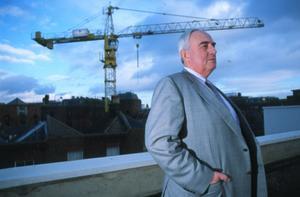Donald Leeper, CIBSE president. Profile in association with ferroli
Donald Leeper is clearly in his element. “I’m getting to sign my first cheques for CIBSE,” he says with a broad smile, looking up from the array of papers that have just been presented to him for authorisation. In fact, just days before taking up the hot seat, the president-elect of the institution feels he has a lot to smile about. “I think the institution is riding on a high,” he says. “It is a very successful organisation, particularly in the past few years – we’re growing hugely, our publications are even more important than they’ve ever been.”
Leeper’s enthusiasm – for his profession, for the institution and for the task that faces him over the next 12 months – is obviously genuine. “It’s such a super time to be practising,” he says, almost lamenting his decision to semi-retire from Zisman Bowyer and Partners, the practice where he spent 39 years of his working life. “There is such huge purpose. We’re a discipline whose time has come.”
Yet the maths graduate turned engineering consultant also has something of the politician about him: he is always resolutely on message and betrays a certain wariness of the media (“don’t quote me on that one” is a phrase that frequently pepper his speech when he feels he may have gone a little too far). This could be a result of past involvement in numerous panels and bodies – including a government advisory panel on construction research – as Leeper denies any overtly political ambition.
Despite this, he is obviously keen to flex his presidential muscle come his imminent inauguration. His main aim for the next 12 months is to continue to drive through the agenda that he began as CIBSE’s Constructing Excellence champion – namely to combat adversarialism. “There is no doubt in my mind that we are, by and large, more adversarial than when I was a young engineer,” he says, lamenting the way in which the industry has changed since he started practising in the 1960s.
He is critical of both the industry and its clients for bringing about a culture of what he calls “risk dumping”, but, ever wary, is keen to point out that he believes this is a culture that grew up almost by accident. “It wasn’t that anyone was doing anything deliberately bad,” he says, “it just happened”. The answer is, of course, collaboration and Leeper is impressed by the work of clients such as Stanhope and BAA towards encouraging mutual cooperation through framework agreements. The next stage is to encourage more clients to take this kind of approach to their projects by getting them to admit that they can influence the direction of the industry as a whole.
“It’s hoping to get the demand side of the industry more openly recognising that they might have contributed a bit to the adversarial nature we’ve got.”
As for the industry itself, Leeper believes that there is a good understanding of the partnering ethos at board level; where it is all too often still missing is at project level. “The project managers believe that they are going to be judged and rewarded on how their one particular project goes,” he says. “So if their project is running into a bit of trouble it becomes a question of a bit of squeezing here, harder thumbs on a supplier there.” A truly collaborative team would tackle any problems as a whole. Again, Leeper anticipates every possible counter to his position, as if he has had to defend it on many occasions before – which he probably has. “I’m not remotely trying to weaken competition,” he asserts. “I’m not being an apologist for poor work.”
Although the industry clearly still has some way to go before it meets Leeper’s cooperative ideal, he is upbeat about its achievements so far. “I think it’s remarkable how far we have come,” he says. “Like any of the big issues in life, there is seldom a Damascus Road experience. We need constant reminders.” And he believes that the realities of project work today – as much as a conscious attempt to shift the cultural landscape – will continue act as such reminders, driving the industry towards its collaborative goal.
In practice these realities include increasing sustainability considerations – requiring the project architect, structural engineer and building services engineer to work together right from the word go – and the latest technology, which acts as an enabler for this kind of integrated approach. “We are far more interdependent as disciplines,” he says. “It’s very exciting because things just weren’t like that when I was a young engineer.”
Leeper is aware that he won’t be able to transform the industry in 12 months but believes that he can help move it further in the right direction. And, if his track record is anything to go by, it’s highly unlikely that we’ll have heard the last of him and his agenda once those 12 months are over.
Source
Building Sustainable Design























No comments yet